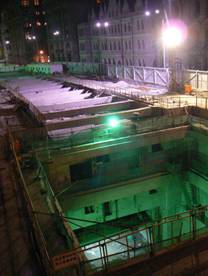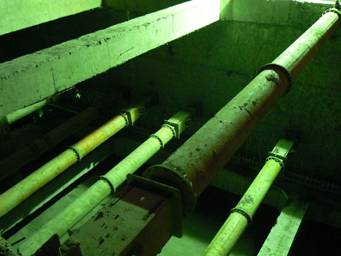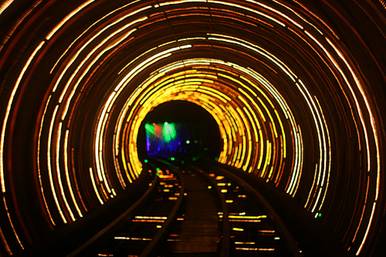It was late on a Sunday night. All the sensible folk were long tucked up in bed. Post-drinks, I was strolling the Bund in search of a taxi. If you live in Shanghai, you’ll know that the Bund has been undergoing renovation for quite some time now, in preparation for the 2010 Expo. For the past few months (and the next few), great swathes of the riverfront have been home to cranes, diggers, and corrugated workers’ huts. It was onto one of these construction sites that I accidentally wandered, just as the hands of the clock tower of the Custom House dragged towards midnight.
The site was bathed in eerie green from the floodlights. There was no-one else around. Walking up to the low perimeter fence, and peering over, what met my eyes hit me like a jackboot to the stomach. Below lay hundreds of feet of nothing, intersected by huge pipes. The only sound was the low hum of passing cabs, the odd car horn, and dripping water from the layers of pipes. I had stumbled upon what very few people get to see in Shanghai: what lies beneath.

I stood and contemplated the chasm in front of me for a while, and took some photos. Looking up, from time to time, at the forest of skyscrapers across the river in Lujiazui, I was struck by a though – in Shanghai we only ever look up. There is always a tall building to capture our gaze, or an overpass groaning with traffic to attract our attention. Even in idle moments, our gaze wanders up, not down. So what is there under our feet? Surely there must be more than just sewage pipes and bilge-water.
Most obviously, there is the Metro. The Shanghai Rail Transit began construction in 1995, the third metro system in China, after Beijing and Tianjin. At present it has eight lines and 162 stations along 225 kilometres, although extensions are in progress, and the network will span 500 kilometres by 2010. Within the immediate city centre, and beneath the Huangpu River and Lujiazui, the metro is a true ‘underground’ or 地铁 (dìti?). However, most of the network is an above-ground light railway system. It’s a common site in most places across the city to see the Metro trundling along overhead, instead of hearing it rumble below. Inside the system itself, it’s all efficient sliding doors, air-conditioned carriages, and shiny plastic seats. You’re never underground for long. Sooner or later, the train ascends from the depths, and you’re surrounded by tower blocks once again. This is very different to London, whose relatively ancient Tube system criss-crosses the city underneath its citizens’ feet. In a city like London, which is low-rise compared to its counterparts in the East, life happens on a lower physical level.

Also passing underground are multiple transport tunnels. The oldest of all is the Dapu Road Tunnel which was completed in 1971 and stretches for 2,739 metres under the Huangpu, connecting Luwan with Pudong. This tunnel, like many, is being widened in anticipation of Expo traffic. The two Yan’an tunnels (north and south) are 2,261 and 2,207 metres respectively, and span the river from Fujian Lu to Yongjiazhai Lu in Lujiazui. Newer tunnels include the Dalian Lu crossing, finished in September 2003, the Outer Ring Road tunnel, also completed in 2003 (the longest road tunnel in Asia) and the Xiangyin tunnel. The newest is the Chongming South Channel Tunnel, which was built last year to connect Pudong to Chongming Island via Changxing Island.

Bund sightseeing tunnel, Shanghai
Heading underground on public transport is one thing; exploring subterranean Shanghai on foot is something different altogether. If you know where to look, there are plentiful opportunities to do this, mainly in the shape of underground markets. Many metro stations have shopping plazas below street level, like the long passageway on the line interchange at Shanghai Railway Station. Then there’s the warren-like shopping area under the Museum of Science and Technology Station in Pudong, and the optical market near the Railway Station.
When all is said and done, Shanghai is very much an upward-looking city, both in its outlook and its geography. There’s always something to catch the eye above street level. However, when you catch a glimpse of what lies beneath, it’s often a pleasant surprise.
***
Related Links
Water Villages: Exploring Shanghai’s Backyard Waterways
Temple City Part II: Judaism in Shanghai
Sky-High Shanghai – Exploring the City’s Tallest Buildings
Warning:The use of any news and articles published on eChinacities.com without written permission from eChinacities.com constitutes copyright infringement, and legal action can be taken.
All comments are subject to moderation by eChinacities.com staff. Because we wish to encourage healthy and productive dialogue we ask that all comments remain polite, free of profanity or name calling, and relevant to the original post and subsequent discussion. Comments will not be deleted because of the viewpoints they express, only if the mode of expression itself is inappropriate.
Please login to add a comment. Click here to login immediately.